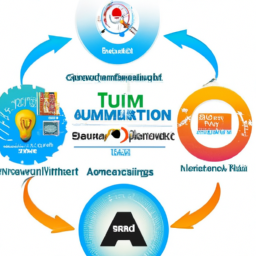The Benefits of Integrating CRM and Marketing Automation
As a business owner or marketer, you want to maximize your efficiency, save time, and improve customer experiences. One way to achieve these goals is by integrating Customer Relationship Management (CRM) with Marketing Automation. CRM and Marketing Automation are powerful tools on their own, but when combined, they become a superhero duo that can take your business to the next level. In this article, we will explore the advantages of integrating CRM with marketing automation.
1. Streamline and Centralize Data
CRM systems are designed to manage and organize customer data. Marketing Automation platforms, on the other hand, automate marketing tasks and campaigns. By integrating CRM with Marketing Automation, you can streamline and centralize all your customer information in one place. This means that your sales team and marketing team can have access to the same accurate and updated customer data, eliminating the need for duplicate data entry or data transfer between systems. It gives your team a complete, 360-degree view of a prospect or customer, enabling them to make informed decisions and provide personalized experiences.
2. Enhance Lead Scoring and Nurturing
Lead scoring is a process that helps you identify the quality of leads based on certain criteria. When you integrate CRM with Marketing Automation, you can take lead scoring to the next level. By analyzing both demographic and behavioral data, the integrated system can assign scores to leads based on their engagement with your marketing campaigns, website visits, email interactions, and more. This allows your sales team to focus their time and effort on the most qualified leads, increasing the chances of conversion.
In addition, the integration allows you to automate lead nurturing based on the lead score. With Marketing Automation, you can set up personalized and automated email workflows triggered by specific lead actions or behaviors. This ensures that your leads receive relevant and timely content, keeping them engaged and moving through the sales funnel.
3. Improve Sales and Marketing Alignment
A common challenge for many businesses is the disconnect between the sales and marketing teams. Integrating CRM with Marketing Automation can bridge this gap and foster better collaboration and alignment between the two departments. When both teams have access to the same data and insights, they can work together more effectively. Marketing can provide sales with qualified leads and relevant customer information, while sales can provide feedback on lead quality and help refine lead scoring criteria. This alignment between sales and marketing ensures a smoother handoff of leads, better communication, and ultimately, higher conversion rates.
4. Automate Marketing Processes
Marketing Automation is all about saving time and automating repetitive tasks. By integrating CRM with Marketing Automation, you can automate marketing processes even further. For example, you can automatically add leads to email lists or trigger personalized emails based on specific CRM events, such as lead status changes or purchases. This not only saves time for your marketing team but also ensures that your customer communications are timely and relevant.
5. Measure and Analyze Marketing ROI
Another benefit of integrating CRM with Marketing Automation is the ability to measure and analyze your marketing return on investment (ROI) more accurately. By connecting marketing activities to actual sales revenue in your CRM system, you can track which marketing campaigns or channels are driving the most revenue. This insight allows you to optimize your marketing efforts, allocate resources effectively, and make data-driven decisions to grow your business.
Conclusion
Integrating CRM with Marketing Automation offers a wealth of benefits for your business. From streamlining and centralizing data to enhancing lead scoring and nurturing, improving sales and marketing alignment, automating marketing processes, and measuring marketing ROI – the advantages are indisputable. So why not maximize the potential of these two powerful tools by integrating them? By doing so, you can save time, increase efficiency, and ultimately drive better results for your business.


